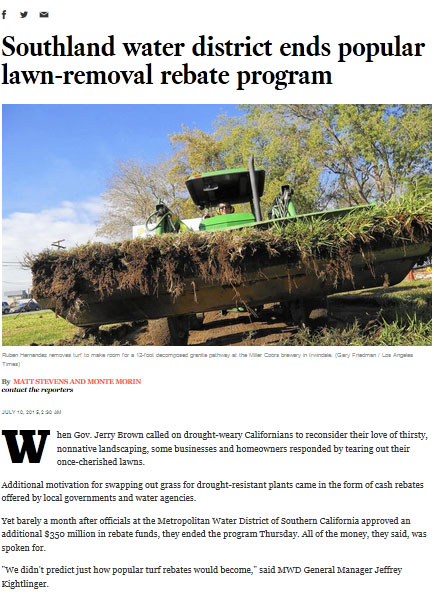GONE BUT NOT FORGOTTEN…
So the rebate craze is gone, and likely for good (though there are some local governments chipping in to extend incentives).
Last month the Los Angeles Times published a piece about rebates that you might find interesting.
http://www.latimes.com/local/california/la-me-mwd-turf-rebates-20150710-story.html
REDUCE REGARDLESS OF REBATES
While rebates may be gone, the challenge to conserve water remains. And while we continue to hear lots of talk about the 50 year El Nino and how it might reverse the trending drought here in California, water company oversights and bloated tier pricing will likely stay at current levels.
What you pay for water is the new incentive to find ways to conserve!
Converting to drought tolerant turf is very cost effective and will pay for itself, often within a year, depending on how extensive the project is.
WITH FALL APPROACHING
Fall is an ideal time to convert water thirsty turf to more drought tolerant options. But you should start planning now.
PREPARING TO CONVERT TO NEW TURF
To convert your lawn from fescue or other high water usage turf to a drought tolerant alternative, you will need to prepare the lawn area as follows:
- Utilize a lawn killer spray to destroy the current turf. Then rake away dead grass, or if you have the equipment you can rototill the the turf and remove grass chunks without applying turf killer.
- Level the area with a rake and remove any rocks and debris
- Next, if you get a lot of weeds, this is an ideal time to do some weed abatement. Apply weed killer to the area. You will want to let the weed chemicals work for 10 days.
- After weed abatement, rake through the lawn area one last time to remove any new growth that occurred during weed abatement.
- Prepare access to the lawn area for the hydroseeding hose and ensure pets and children are kept safe and away from the equipment and work area.
- Have the area hydroseeded with the new seed. You do not need to worry about fertilizer or nutrients. We incorporate all of that into our hydroseeding slurry when we apply seeds.
- Keep in mind, for several days after hydroseeding you will need to keep foot traffic low and ground moisture high.
- In approximately 3 days you will begin to see growth. Within 3 weeks you will notice the turf growing more dense.
- Early on with hydroseeding, you will want to keep the area hydrated, but be sure not to soak it or drown new growth. Once established you can then reduce watering significantly.
- Once the lawn area is stable, cut the new grass, leaving it slightly longer than normal. You can now begin to care for your new turf as you would any lawn.

